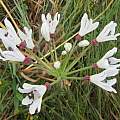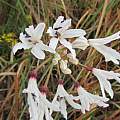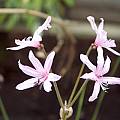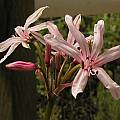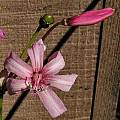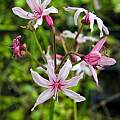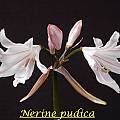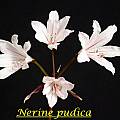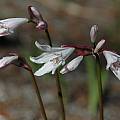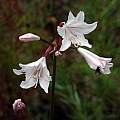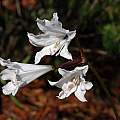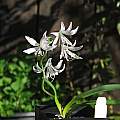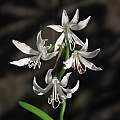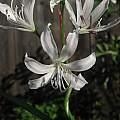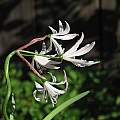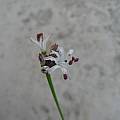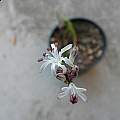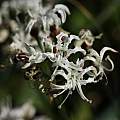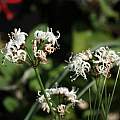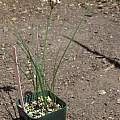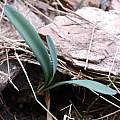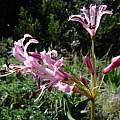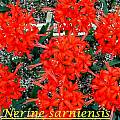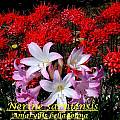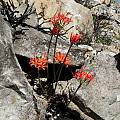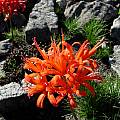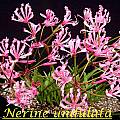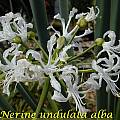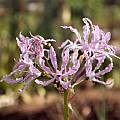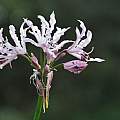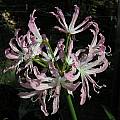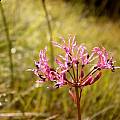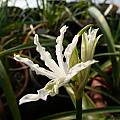Nerine is a genus of 25 species in the family Amaryllidaceae 21 of which are endemic to the geographic areas of South Africa, Lesotho and Swaziland. The other 4 occur throughout southern Africa. Only 4 species are winter growing and 21 are summer growing, a subset of which are evergreen. Graham Duncan's Grow Nerines and The Amaryllidaceae of Southern Africa are good resources. In cultivation, Nerine has been widely hybridized. See Nerine Hybrids for photos of hybrids.
Information and photographs illustrating Nerine species n-z can be found on this page.
Nerine pancratioides Baker is native to KwaZulu-Natal where it is found in grassland wetlands and seepage areas. It flowers from late summer to mid-autumn. It has clusters of white funnel-shaped flowers with broad tepals. Flowering is enhanced by fire after a cold, dry winter. For more information consult this article by Charles Craib. Photos below from iNaturalist taken by berthapi2 and shared under a CC BY-NC license.
Nerine platypetala McNeil is a summer growing species which occurs in perennial marshes of Mpumalanga Province. It has unique broad, flat perianth segments that are pale pink with darker pink central keels at the base. Plants are deciduous in winter. The first photo by Cameron McMaster is one grown from seed collected in Mpumalanga. The next two photos by Mary Sue Ittner are of plants flowering in September 2004 in Northern California. The second photo shows a bud, a close-up of the flower with the broad segments, and a seed already formed. The final photo is by Tom Mitchell, of a plant grown from Silverhill seed, flowering in late August in cultivation in the UK.
Nerine pudica Hook.f. is a winter growing species from the West Cape Province. This species is extremely good for container growing or for larger rock gardens. In the ground in Northern California, it is dormant in summer, blooms in fall, and grows in the winter. As with all Nerine species, extremely good drainage is a must. A mix of 30% organic and 70% inorganic material seems suitable. When young, the seedlings can be fertilized with a dilute mineral fertilizer but as the bulbs mature, fertilization may cause the bulbs to produce lots of leaves in expense of flowering. The bulbs must remain dry in the summer. Photos below by Bill Dijk, Bob Rutemoeller and Mary Sue Ittner shows a form with almost pure white bell shaped flowers on 12 inch (30 cm) stems and neat blue-grey foliage.
The photos below are of a specimen photographed by Nhu Nguyen. This year there seems to be a deformity in the peduncle, causing it to twist.
Nerine pusilla Dinter is a diminutive summer growing species with a distinct winter dry period native to east central Namibia. The bulbs are elongate, solitary, and hold 2-4 filiform leaves. The only way to increase their numbers is through seeds. Since the plants are tiny, they should only be grown in containers with their necks just resting above the soil. Extremely sharp drainage is a must. In plastic containers, they should be watered once every 10-14 days during growth and be completely dry during winter dormancy.
Nerine rehmannii (Baker) L.Bolus is a summer growing species native to Swaziland, central Gauteng, western Mpumalanga, and the Northern Provinces of South Africa where it grows on rocky outcrops. It is a dwarf species with 1-2 filiform leaves (up to 9 cm long) and white flowers with wavy and recurved tepals and violet anthers. It is dormant from mid-autumn until early summer in its natural habitat, but can be evergreen in cultivation. Photos 1-2 were taken by Alessandro Marinello and photos 3-5 were taken by Nhu Nguyen.
Nerine ridleyi E.Phillips is a winter growing species which appears to be restricted to the Hex River, Franschhoek and Wemmershoek Mountains, and Fonteintjiesberg, West Cape Province, South Africa. It is found in fynbos habitat where large colonies grow in fissures of sandstone ledges or scattered around bushes from 1100-1400 m. Because of the elevation, it is not unusual for the bulbs to be subjected to snowfall and sub-zero temperatures for several days in winter. It flowers in late summer or autumn, followed by growth of leaves. In the wild, flowering may be stimulated by fire. In cultivation, it seems to be shy to flower. It is evergreen, dropping only the oldest leaves during summer dormancy. The bulbs do multiply but not as quickly as N. sarniensis. Flowers are self fertile, although plants have not flowered within 16 years from seeds (Graham Duncan 2008). Plant bulbs with their necks fully exposed with morning sun and afternoon shade or semi-shade throughout the day. In plastic containers, water well once every 10 days in the winter growing season and once every 3-4 weeks in the summer for bulbs that stay evergreen and once or twice during summer for bulbs that go completely dormant. Treatment with a systemic insecticide at the beginning of the growing season is suggested (Duncan 2008). Photos below from iNaturalist taken by Nick Helme and shared under a CC BY-NC license.
Nerine sarniensis (L.) Herb. is a winter growing species from West Cape Province, South Africa (naturalised in France, Azores, Madeira, (UK?)). This species is commonly called the 'Guernsey Lily', (the species name is derived from Sarnia, the Latin name for the Guernsey Islands) because bulbs were allegedly washed up during a seventeenth century shipwreck in the Guernsey Islands, and flowered so well there that the botanists first thought that this was its natural home (this story is contested by some historians). The species is relatively rare in cultivation, but as the main parent of 300 years of Nerine breeding, hundreds of different forms had been produced. The collection at Exbury Gardens in the UK is the largest in the world of N. sarniensis selections and hybrids. Flowers appear at the beginning of the growing season before or at the same time as appearance of leaves.
People who grow N. sarniensis selections often report that many of their bulbs don't bloom every year, and there has been a lot of discussion of various techniques to get them to bloom. In the Netherlands, where the species is raised in greenhouses for cut flowers, growers report that the bulbs need variation in soil temperature during the year in order to bloom well: relatively warm at bloom time, and relatively cool after that. Their recommendation is to plant in the fall and grow at a soil temperature of 17-21 °C (62-70 °F). If soil temps are lower in the fall, leaves and roots will grow a lot, but the flower buds may abort. Growing at 25 °C/77 °F or above tends to produce rot. After flowering is finished, around November in the northern hemisphere, reduce soil temperatures to 9-12 °C (42-55 °F) (or possibly lower -- temps lower than 9 °C were not tested in the research). If the plants stay too warm during this period, the bulbs will not store food properly and may die during the dormant season.
In the spring, gradually increase temperature as the foliage starts to yellow. Bulbs are generally dormant by the end of April, and should spend the summer in the 17-21°C(62-70 °F) range. This helps the flower bud develop inside the dormant bulb. (Van Brenk & Benschop 1993). It takes 4-5 years for this species to mature from seed (Nick de Rothschild).
On the PBS discussion list, several N. sarniensis growers described their growing techniques:
- Nicholas de Rothschild discussed the growing conditions used for the Exbury Nerines here.
- Matt Mattus grows more than a hundred bulbs in a greenhouse in Massachusetts. He described his approach here.
- Michael Homick has a large Nerine collection in central California. He discussed his growing techniques here.
There is also a good article on Nerine-growing in the UK here.
Nerine sarniensis can be grown outdoors if your climate approximates the mild Mediterranean pattern the bulbs evolved in. Otherwise, you'll probably need to use a greenhouse. If you are growing in pots, be careful not to let the dormant bulbs dry out utterly in summer -- their roots remain active in summer, and the bulbs will wither if they get completely dry. Depending on the summer humidity and temperature in your area, this may mean that you need to water the pots periodically, or you may be able to just leave the pots alone.
The first two photos are by Bill Dijk. The last two photos were taken in habitat by Cameron McMaster who wrote: "This is a nerine confined to the Winter Rainfall region and is fairly common and widespread. These pictures were taken in April on a rocky outcrop at the highest point on the road between Bot River and Villiersdorp in the Western Cape. As you see, the area had recently burned which stimulated the Nerines to flower."
Some Nerine sarniensis selections are shown on our Nerine Hybrids page.
Nerine transvaalensis L.Bolus was only recorded from grassland in an area east of Johannesburg, South Africa in 1924. It may be extinct but would be a summer growing species, probably flowering in autumn and dormant in summer
Nerine undulata (L.) Herb., syn. Nerine alta W.F.Barker, Nerine aucta (Tratt.) M.Roem., and Nerine flexuosa (Jacq.) Herb., is a summer growing species native to the Eastern Cape Province, South Africa. It occurs on steep slopes in partial shade. The plants are almost evergreen with a short dormancy period. The plant produces very dainty spider-like flowers which can give a wonderful display when mass planted. The soft pink flowers are produced abundantly on 10-12 in (24-30 cm) stems. Bulbs multiply profusely. The first two photos by Bill Dijk include a white version that is uncommon, but even more desirable for pots and containers. The third photo from Cameron McMaster is of one in the garden, grown from seed collected near Bedford, E. Cape. The fourth photo is from Bert Zaalberg. The last photo by Mary Sue Ittner is of a plant received as a cross between Nerine flexuosa, now considered to be this species, and Nerine undulata.
The in situ photo below by Cameron McMaster near Stutterheim shows Nerine alta W.F.Barker, now included in N. undulata. Nerine alta comes from wetlands where it is winter dormant and summer growing. It is also hysteranthous (leaves appear after the flowers). Petals are very fine tending to roll into tubes but strongly crisped and darker pink than other forms. This form does not multiply vegetatively and must be grown from seed to increase numbers.
The following photos by Cameron McMaster and Alessandro Marinello show plants that used to be Nerine flexuosa (Jacq.) Herb., now included in Nerine undulata.
